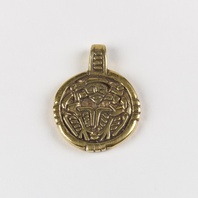
Viking Objects
Reproduction Pendant with an Odin Motif
This reproduction of a cast silver, gilded pendant featuring an image of a one-eyed figure with two birds has been interpreted as Odin and his two ravens, Huginn and Muninn. The original pendant was found at Winteringham, Lincolnshire. There are a number of close parallels which establish the wide currency of this subject group. These include numerous examples from Russia and two from Sweden, including some with silver gilding. A silver pendant with a related, but distinct design is known from Sjælland, Denmark.
Read More
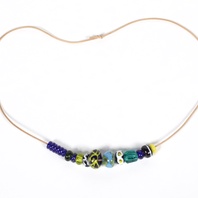
Viking Objects
Reproduction York Glass Beads
This necklace with glass beads is based on originals from York. Glass beads were a coveted item with some being imported from as far away as the Middle East. They were manufactured by specialised artisans who would heat various coloured glass rods over a furnace and melt the glass onto a metal stick to form different shaped beads.
Read More
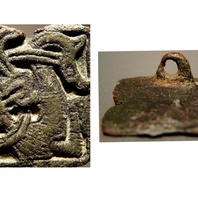
Viking Objects
Mammen-Style Square Brooch (LEIC-0BFA74)
This small brooch features a bird depicted in the Mammen style. This style of brooch appears to have been produced in the Danelaw but, generally, Mammen-style decoration is rare in Britain. This brooch from Linwood, Lincolnshire, is paralleled by examples from West Stow Heath, Suffolk, and Bergh Apton, Norfolk, but further examples from Cambridgeshire and East Anglia were found in 2015 and 2016. It is a type which has Carolingian-inspired shapes and Scandinavian decoration. Such brooches were an accessory for women who wore Scandinavian dress. For more information on Scandinavian jewellery in England check out our blog: Brooches, Pendants and Pins: Scandinavian Dress Accessories in England.
Read More
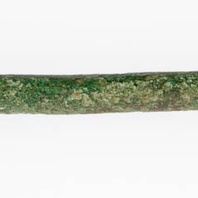
Viking Objects
Copper-Alloy Needle (CM. 1845-2008)
A cylindrical copper-alloy needle fragment with a broken shaft. Needles were a common textile tool and could be made from bone, metal or wood. They are usually associated with women and finds like this indicate that the inhabitants of the Viking camp at Torksey included women and children alongside the warriors of the Great Heathen Army.
Read More
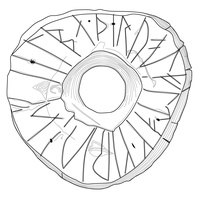
Viking Designs
Drawing of the Saltfleetby Spindle Whorl
Drawing of a lead alloy spindle whorl from Saltfleetby, Lincolnshire showing part of the runic inscription. For further information, see the entry for the original item.
Read More
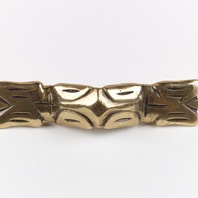
Viking Objects
Reproduction Ansate Brooch
A reproduction, copper alloy, ansate brooch based on an example from York. Two copper alloy examples of ansate brooches, also known as equal-armed brooches, were found at 16-22 Coppergate. These brooches are characterised by a narrow arched bow and terminal heads of identical form. The design of the brooches from Coppergate are a variant known as ‘caterpillar’ type. Asnate brooches are dated to between the seventh and ninth centuries though the finds at Coppergate may extend their popularity into the tenth century. The ‘caterpillar’ variety is typically geographically limited to areas bordering the North Sea. The quantity found in England, however, may indicate local manufacture. Brooches were a typical part of female dress. Scandinavian brooches came in a variety of sizes and shapes which included disc, trefoil, lozenge, equal-armed, and oval shapes. The different brooch types served a variety of functions in Scandinavian female dress with oval brooches typically being used as shoulder clasps for apron-type dresses and the rest being used to secure an outer garment to an inner shift. Anglo-Saxon brooches do not match this diversity of form with large disc brooches being typical of ninth century dress styles with smaller ones becoming more popular in the later ninth and tenth centuries. However, since disc brooches were used by both Anglo-Saxon and Scandinavian women they are distinguished by their morphology. Scandinavian brooches were typically domed with a hollow back while Anglo-Saxon brooches were usually flat. Moreover, Anglo-Saxon brooches were worn singly without accompanying accessories.
Read More
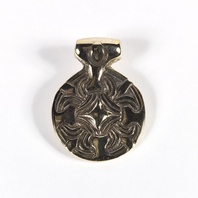
Viking Objects
Reproduction Terslev Pendant
Terslev style, where Scandinavian ring-chain patterns are the main decorative component, is a subcategory of the Borre style and takes its name from the silver hoard discovered in Terslev, Denmark. The decoration comprises a series of ring-knots related to the Borre ring-chain. The Terslev style occurs mainly on brooches and pendants, including both high-quality gold and silver jewellery as well as lower-end base metal items. The cast base-metal ornaments, such as those made of copper alloy, were intended to imitate the higher-end gold and silver jewellery, and often employed techniques such as gilding to achieve this. The Terslev designs that occur in England extend the repertoire by introducing new Scandinavian motifs hitherto unrecorded in Scandinavia. For more information on Scandinavian jewellery in England check out our blog: Brooches, Pendants and Pins: Scandinavian Dress Accessories in England.
Read More
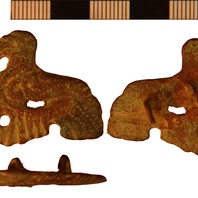
Viking Objects
Viking Bird Brooch (NLM-612074)
This brooch is classified as Weetch’s type 30.C and is decorated with an openwork design representing a bird in profile. For more information on Scandinavian jewellery in England check out our blog: Brooches, Pendants and Pins: Scandinavian Dress Accessories in England.
Read More
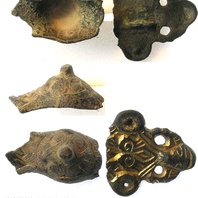
Viking Objects
Fragment of an Equal-Armed Brooch (SWYOR-FAFC04)
A fragment of a Viking Age equal-armed brooch found at Harworth Bircotes, Nottinghamshire. This fragment is the boss of the brooch and resembles brooches found at Birka, Sweden. Its decoration consists of a Borre style animal with gripping arms or legs. This is one of only six Scandinavian, Viking period equal-armed brooches recorded in England. For more information on Scandinavian jewellery in England check out our blog: Brooches, Pendants and Pins: Scandinavian Dress Accessories in England.
Read More
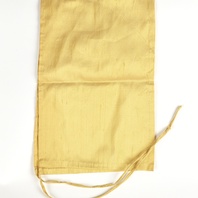
Viking Objects
Reproduction Silk Headdress
A yellow silk headdress based on examples found in Lincoln, York and Dublin. The silk would have been imported from the Eastern Mediterranean.
Read More
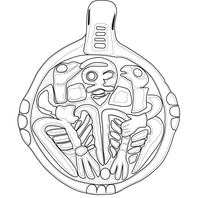
Viking Designs
Drawing of the Winteringham Pendant
A drawing of a cast silver, gilded pendant which has been interpreted as representing an image of Odin and his two ravens Huginn and Muninn. There are a number of close parallels which establish the wide currency of this subject group. These include numerous examples from Russia and two from Sweden, including some with silver gilding. A silver pendant with a related, but distinct design is known from Sjælland, Denmark. With some exceptions, pendants were generally worn by women as part of their Scandinavian dress.
